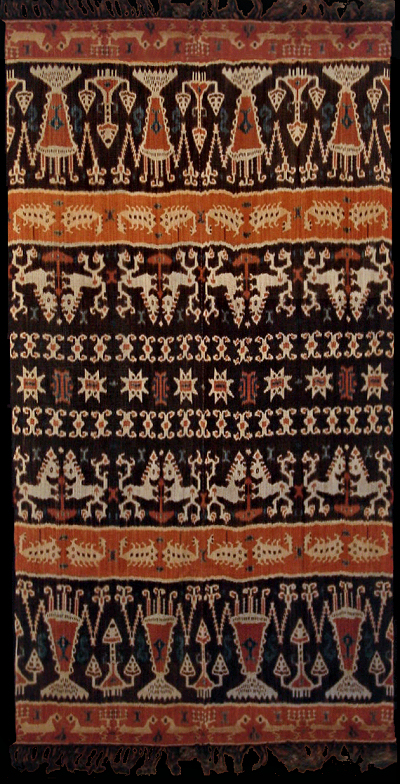| |
 
 | | | |
089 Sumba, East Sumba
Hinggi (men's blanket)
| | Locale: | Melolo, probably. | | Period: | 1920-1930 | | Yarn: | To be investigated. | | Technique: | Warp ikat | | Panels: | 1 | | Size: | 122 x 234 cm (4' 0" x 7' 8") LW: 1.92 | | Design: | Classic nine band field division, the widest band showing lobsters and small skull trees. The second widest show mounting lions, inspired by Dutch heraldry. The bands closest to the extremities show a feline motif, which is relatively uncommon. The presence of aquatic animals always points to high rank, as do symbols of power such as the mounting lions. | | Comment: | Cloth stands out by the quality of the weaving, which is very tight, creating perfect diagonals and curves. The colouration is intense, showing the hand of a master dyer. Excellent state of preservation. | | Background: | Chapters on Sumba and East Sumba. | | Compare: | 187 188 | | Sources: | Similar combination of lobsters and skull trees on early 20th C. hinggi panel in Roemer Museum, depicted in Khan-Majlis, Woven Messages, Fig. 213. Near-identical rendering of lobsters on late 19th to early 20th C. hinggi from Melolo in Wereldmuseum Rotterdam, depicted in Adam, Forshee, c.s. Decorative Arts of Sumba, p. 96, and on another Melolo from the same period, p. 109. Similar to early 20th C. hinggi in Khan Majlis, Indonesische Textilien, Wege zu Goettern und Ahnen, Fig. 408 en one on Fig. 410. | | |

©Peter ten Hoopen, 2024
All rights reserved.
|
|


